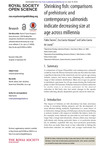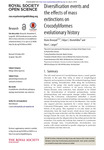Search
Now showing items 1-10 of 17
Mitigating the Goldilocks effect
(2014)
In ichnology, the Goldilocks effect describes a scenario in which a substrate must be ‘just right’ in order for tracks to form—too soft, the animal will be unable to traverse the area, and too firm, the substrate will not ...
Shrinking fish: comparisons of prehistoric and contemporary salmonids indicate decreasing size at age across millennia
(The Royal Society, 2014)
A comparison of Upper Palaeolithic and contemporary salmonid vertebrae from the Iberian Peninsula indicates that there has been a significant decrease in the mean body size for a given age among Atlantic salmon and brown ...
Tooth serration morphologies in the genus Machimosaurus from the Late Jurassic of Europe
(2014)
Machimosauruswas a large-bodied durophagous/chelonivorous genus of teleosaurid crocodylomorph that lived in shallow marine and brackish ecosystems during the Late Jurassic. Among teleosaurids, Machimosaurusand its sister ...
Revision of the Late Jurassic teleosaurid genus Machimosaurus
(2014)
Machimosaurus was a large-bodied genus of teleosaurid crocodylomorph, considered to have been durophagous/ chelonivorous, and which frequented coastal marine/estuarine ecosystems during the Late Jurassic. Here, we revise ...
Diversification events and the effects of mass extinctions on Crocodyliformes evolutionary history
(2015)
The rich fossil record of Crocodyliformes shows a much greater diversity in the past than today in terms of morphological disparity and occupation of niches. We conducted topology-based analyses seeking diversification ...
Tiarajudens eccentricus and Anomocephalus africanus, two bizarre anomodonts (Synapsida, Therapsida) with dental occlusion from the Permian of Gondwana
(The Royal Society, 2015)
Anomodontia was a highly successful tetrapod clade during the Permian and the Triassic. New morphological information regarding two bizarre basal anomodonts is provided and their palaeoecological significance is explored. ...
Baleen boomand bust
(The Royal Society, 2015)
A new, fully dated total-evidence phylogeny of baleen whales (Mysticeti) shows that evolutionary phases correlate strongly with Caenozoic modernization of the oceans and climates, implying a major role for bottom-up physical ...
Estimating cranial musculoskeletal constraints in theropod dinosaurs
(2015)
Many inferences on the biology, behaviour and ecology of extinct vertebrates are based on the reconstruction of the musculature and rely considerably on its accuracy. Although the advent of digital reconstruction techniques ...
First report of Plesiochelys etalloniandTropidemys langiifrom the Late Jurassic of the UK and the palaeobiogeography of plesiochelyid turtles
(2016)
Plesiochelyidae is a clade of relatively large coastal marine turtles that inhabited the shallow epicontinental seas that covered western Europe during the Late Jurassic. Although the group has been reported from many ...
The unexpected survival of an ancient lineage of anseriformbirds into the Neogene of Australia
(2016)
Presbyornithids were the dominant birds in Palaeogene lacustrine assemblages, especially in the Northern Hemisphere, but are thought to have disappeared worldwide by the mid-Eocene. Now classified within Anseriformes ...










